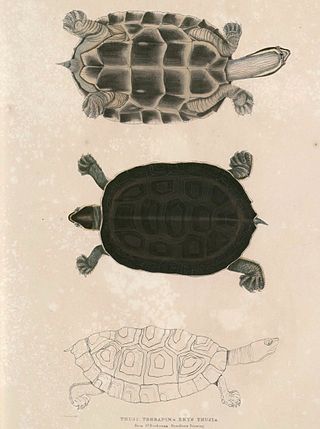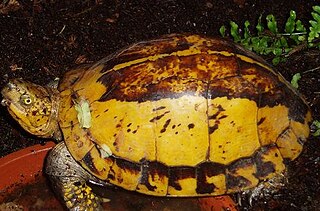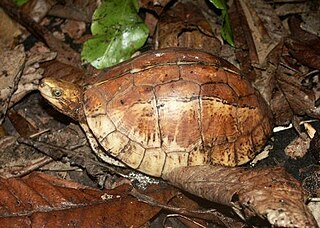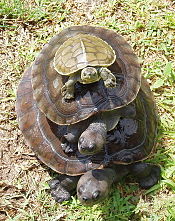
The Geoemydidae are one of the largest and most diverse families in the order Testudines (turtles), with about 70 species. The family includes the Eurasian pond and river turtles and Neotropical wood turtles. Members of this family are commonly called Leaf turtle.

The northern river terrapin is a species of riverine turtle native to Southeast Asia. It is classified Critically Endangered by the IUCN and considered extinct in much of its former range.

The Amboina box turtle or Southeast Asian box turtle is a species of Asian box turtle.

The Asian leaf turtle is a species of turtle found in Southeast Asia. They are quite common in the pet trade; their carapaces resemble that of a Cuora amboinensis hybrid.

Oldham's leaf turtle is a species of turtle in the family Geoemydidae.

The black pond turtle, also known as the spotted pond turtle or the Indian spotted turtle, is a species of freshwater turtle endemic to South Asia. It belongs to the monotypic genus Geoclemys.

The brahminy river turtle or crowned river turtle is a species of turtle in the family Geoemydidae. The species is endemic to South Asia.

The brown roofed turtle is a species of turtle in the family Geoemydidae. The species is endemic to South Asia. Two subspecies are recognized.

The golden coin turtle, also known commonly as the Chinese three-banded box turtle and the Chinese three-striped box turtle, is a species of turtle in the family Geoemydidae. The species is native to southern China. There are two recognized subspecies.

Asian box turtles are turtles of the genus Cuora in the family Geoemydidae. About 12 extant species are recognized. The keeled box turtle is often included in this genus, or separated in the monotypic genus Pyxidea. Genus Cuora is distributed from China to Indonesia and the Philippines, throughout mainland Southeast Asia, and into northern India and Bhutan.

The Indochinese box turtle, Vietnamese box turtle, or flowerback box turtle is a species of Asian box turtles from China, northern and central Vietnam, Laos, and possibly northeastern Cambodia. It is found in high altitude woodland where it tends to hide in the undergrowth. There is considerable confusion as to the taxonomy of this species with several subspecies being recognised by some authorities. and not by others. The International Union for Conservation of Nature has rated its conservation status as "critically endangered".

The Chinese box turtle, also known as the yellow-margined box turtle, or golden-headed turtle, is a species of Asian box turtle. Taxonomically, it is called Cuora flavomarginata.

Mauremys reevesii, commonly known as the Chinese pond turtle, the Chinese three-keeled pond turtle, or Reeves' turtle, is a species of turtle in the family Geoemydidae, a family which was formerly called Bataguridae. The species is native to East Asia.

Bourret's box turtle, also known commonly as the central Vietnamese flowerback box turtle and the Indochinese box turtle, is a species of turtle in the family Geoemydidae. The species is endemic to Southeast Asia.
Cuora serrata, originally described as Cuora galbinifrons serrata and later considered a distinct species, are hybrid turtles as shown by genetic studies. These hybrids are bred in the wild and were documented for the first time in the wild in 2005, but not in captivity as "novelty" pets as suggested by James Parham and Bryan Stuart, between the keeled box turtle and taxa of the Indochinese box turtle complex. Unnamed hybrids of several other Cuora taxa are also known, as are intergeneric hybrids like Mauremys iversoni, a hybrid between Cuora trifasciata and Mauremys mutica which are intentionally produced in Chinese turtle farms.

Cyclemys is a genus of freshwater turtles, commonly referred to as Asian leaf turtles, from the family Geoemydidae. The genus occurs throughout Southeast and South Asia, and currently contains seven species.

The Assam leaf turtle is a species of turtle in the family Geoemydidae. The species is found in India, Nepal, Bhutan, and Bangladesh.

The Myanmar brown leaf turtle is a species of Asian leaf turtle found in Myanmar.

Box turtle is the common name for several species of turtle. It may refer to those of the genus Cuora or Pyxidea, which are the Asian box turtles, or more commonly to species of the genus Terrapene, the North American box turtles. They are largely characterized by having a shell shaped like a dome, which is hinged at the bottom, allowing the animal to close its shell tightly to escape predators. Furthermore, the two genera are very different in habitat, behavior and appearance, and are not even classified in the same family. Even though box turtles became very popular pets, their needs in captivity are complex and the capture of turtles can have serious detrimental effects on the wild population.























